

'Au i ke kai me he manu ala. "Cross the sea like a bird." To sail across the sea.
From Mary Kawena Pukui’s
‘0lelo No‘eau: Hawaiian Proverbs and Poetical Sayings #237
(Bishop Museum Press 1983)
Kealakekua Bay, on the west side of the Big Island of Hawai'i, is today a quiet spot. A few permanent houses are along the southern part, mostly vacation rentals near an early 20th century cement pier. Only kayakers launch there now, to paddle over to the north end of the bay, where the Captain Cook monument gleams white in the distance. Looking across the bay to the monument, all one ever sees are a few kayaks, a few anchored and deserted boats on the south edge of the bay, and maybe a tourist boat from Kailua bringing in people to snorkel and dive under the monument. Spinner dolphins can often be seen near the shore.

Kealakekua Bay today, looking north to the monument that marks the place Cook died. A large village once occupied all the area to the left of the monument. Tourist snorkeling ship to right of monument.
When Captain James Cook of England sailed into the bay on January 17, 1779, it was to a very different scene. Perhaps 10,000 people lived in two villages on the north and south ends of the bay. According to the accounts of Cook and some of his crew, thousands took to the water in canoes that were so thick in the bay that according to one eyewitness, one could walk across the bay to shore stepping from canoe to canoe. (One eyewitness counted some 1,200 canoes.) Swimmers were so thick around Cook's ship that one crewman compared them to schools of fish. As swimmers and paddlers began to climb up ropes on one side of the ship, there was worry they might capsize it.
When Cook had landed on Kaua'i a year earlier, he did not know that he had stumbled upon the most hierarchical chiefdoms in Polynesia, ones that some archaeologists believe had developed into a group of four small states, the first and at that point only ones in Polynesia. With a land area second only to New Zealand, the population of the islands making up Hawai'i has conservatively been estimated at a minimum of 250,000 people in 1778-79. Many believe that the true population was closer to a million people, which is almost the same size as the current population of Hawai'i. Those facts alone make Hawai'i deserving of special mention in a prehistory course such as this one.
In sailing to Hawai'i from the Marquesas, voyagers not only had to sail some 1,900 miles, but had to cross from the southern to the northern hemisphere. It is a mind-boggling voyage to contemplate. As in all the Polynesian voyages, there is reason to belief that these early settlers were on a purposeful colonizing voyage, bringing with them domesticated plants and animals. (Click here for a list of plants--sometimes called "canoe plants"--brought to Hawai'i on the initial or subsequent voyages.)
Some archaeologists believe that Hawai'i was first colonized between 300-600 AD, though this is not directly based on archaeological evidence. After 600 AD there is ample evidence, and the fishhook and adze styles that the colonists brought with them indicate they came from the Marquesas Islands to the south. Upon arrival they immediately began the modification of the landscape typical of horticulturalists in all areas, including Oceania. Settling first in the wetter windward valleys of the islands, the colonizers began to clear the land of native vegetation and trees, with forest clearance clearly established from the evidence of pollen ca. 800 AD. Hunting almost certainly also contributed to the extinction of several species of flightless birds which had evolved on the islands.
In the Hawaiian archipelago the settlers encountered rainfall differences from windward to leeward sides of the islands, as well as great altitude differences, particularly on the Big Island and Maui. In addition, there were major differences due to the relative age of the islands. The older islands of Kaua'i, O'ahu, Moloka'i and the western half of Maui had deeper soils, eroded valleys and more permanent streams than the younger eastern part of Maui and the even younger Big Island. Reefs had had time to develop more completely around the older islands, and hence the reef fishing was better. These environmental differences were to become important in the prehistory of the islands.
Population in Hawai'i increased quickly, and by 900 AD people had started to move out of more favorable windward valleys, with their increasingly developed pondfield horticulture, into ecologically less favorable areas. For the 500 years after 1100 AD Hawai'i experienced almost exponential population grown, production intensified, a system of hierarchical territorial land units was formalized, elaborate, monumental, and labor-intensive ritual, horticultural,and aquacultural architecture was developed, and the established chiefdoms rapidly moved to consolidate power. The ahupua'a system developed, where territory was owned not by a descent group, but by paramount chiefs (ali'i ai moku) whose control by 1600 was often of an entire island, or more. Religion was used to support the authority of the chiefs, and an upper class, the ali'i developed to include a priestly class. Commoners retained use-rights to work the land, in return for payment in produce and labor to the chief, who in turn provided protection that was supernatural (via support for the priests and temples), economic (via stratified redistributive exchange), and physical (by denying access to rival chiefs). An elaborate kapu (taboo) system also developed, including appropriate behavior in the presence of the chief. The kapu system also forbid women to eat pig, bananas, and certain fish, and required them to cook and eat their food separately from men, which particularly for the ali'i can be verified archaeologically. Other parts of the kapu system, such as that forbidding catching skipjack tuna (aku) and mackerel scad ('opelu) during alternating six month periods during the year, can be viewed as a way to preserve the resource base during a period of rapid population growth.
Monumental public works developed, based on religion (the various temples or heiau) and also on the intensification of production, both horticulture and aquaculture. The chiefs of the western Hawaiian islands were heavily involved in irrigation works for farming, but perhaps the most impressive horticultural achievement was what is called the Kona field system on the Kona side of the Big Island. Farming on the leeward side of the Big Island started by 1000 AD, initially at higher and wetter elevations. Here began an elaborate system of walls, in part designed to catch and direct runoff and preserve soil, as well as to mark boundaries, which by the 1700's extended from 2,500 feet elevation down to the coast in some areas, and from South Kohala to the northern border of Ka'u district, encompassing over 50 square miles. Every possible place was cultivated, and remnants of this field system are evident today.
The walls of the field system are not the only ones found in the islands. The largest free standing wall is located at Pu'uhonua o Honaunau, now a National Historic Park, on the Big Island. Portions of this site are surrounded by a massive wall, over 1,000 feet long with an average height of 12 feet and a base 17 feet wide.
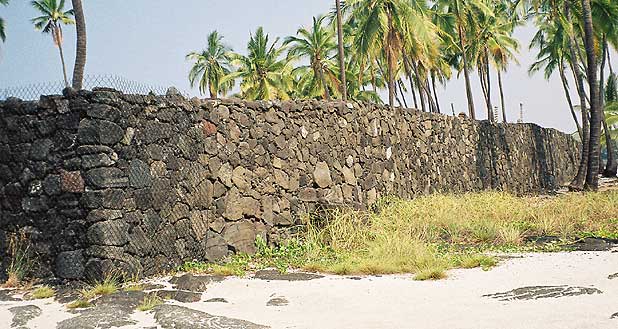
Great Wall at Pu'uhonua o Honaunau National Historical Park
Hawai'i in addition was one of the first places to develop aquaculture using fishponds. There were several types of fishponds, though the most impressive was the loko kuapa, which were stone or coral walled ponds built into the sea itself, and containing one or more sluice gates. Walls were often several thousand feet long, and averaged three to six feet high and at least seven feet wide. The largest loko kuapa had walls 6,300 feet long, and one pond had walls thirty-five feet wide at the base. Enormous energy was expended, on the direction of the chiefs, to build and maintain such walls, and the ponds themselves. Kamehameha I was reported to have used 10,000 men to repair two large loko kuapa on Maui, an endeavor which took several months. Presumably it would have taken at least that many men and that much time to build one, something which could only have been accomplished by a paramount chief. Kaloko Fishpond, shown below, is an example of a loko kuapa.
. 
Wall of Kaloko Fishpond (built ca 1200 AD, in process of restoration; people on the wall for scale) in Kaloko-Honokohau National Historical Park, near Kailua Kona on the Big Island. Here the wall cuts off a small bay.
A second common type of fishpond was the loko pu'uone, a pond near the shore formed by the development of a barrier beach or sand berm. The Hawaiians maintained such ponds, and usually added sluice gates to the pond. 'Aimakapa pond, shown below, is an example of this type of pond.

Sand Berm of 'Aimakapa Fishpond, with ocean on the left, pond on the right. Located in Kaloko-Honokohau National Historical Park, Kailua Kona, HI

Another View of 'Aimakapa Pond (White wall/grey roof in background center is the modern Costco)
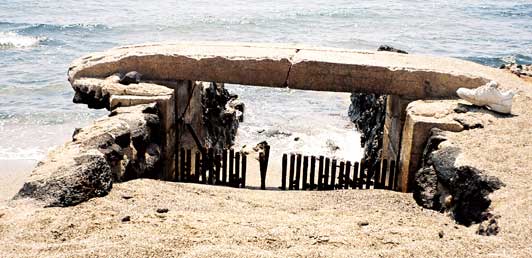
Ruins of small "modern" 1950's Sluice Gate (makaha) at 'Aimakapa Pond (shoe at right for scale)
Hawai'i was also home to several fishtraps, of which the best preserved is 'Ai'opio Fishtrap in Kaloko-Honokohau National Historical Park. Click here for photo. Fish could swim over the walls or in through lanes at high tide, and were trapped during low tide.
At least 360 fishponds and traps were built on the islands, most if not all still in use at the time of Cook's arrival. The ponds were not equally distributed, with O'ahu and Moloka'i in particular being noted for their numerous large fishponds. The ponds were used both to store fish, and to raise baby fish. By the 1700's, and probably much earlier, fish from the fishponds were reserved for the ali'i, though no doubt some were redistributed to the specialists supported by the ruling class.
Religion was used to legitimatize the power of the chiefs to a degree that has also led many to compare Hawai'i to early states in other regions of the world. Building and rebuilding heiau was a common practice as one chief either peacefully, or via warfare, followed the previous ruler of an area or an entire island. Particularly on the younger islands of Maui and the Big Island, and most completely on the Kona side of the Big Island, chiefs exercised a cycle of territorial conquests, often culminating in the rededication of a heiau by the sacrifice of the previous chief. The heiau themselves were functionally differentiated, some marking individual land units, some associated with agriculture, some with flowing water, some with procreation, and some luakini heiau associated with the God Ku, a human sacrifice-demanding god of war. The heiau were generally rectangular stone platforms, often massive, some with multiple stone platforms on top. Wooden and thatch structures topped the heiau. Over 150 still existed on the Big Island alone in the early 1900's, and a few have been preserved or restored.
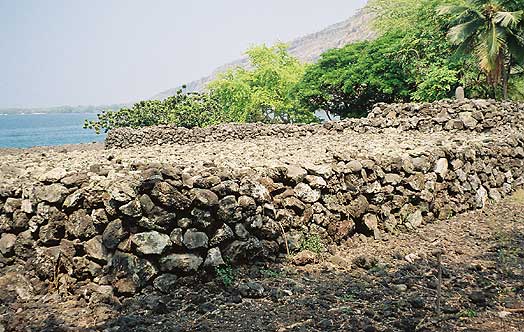
Hikiau Heiau, a luakini heiau on the south shore of Kealakekua Bay. One of Cook's sailors is reported to be buried in the platform of this heiau.
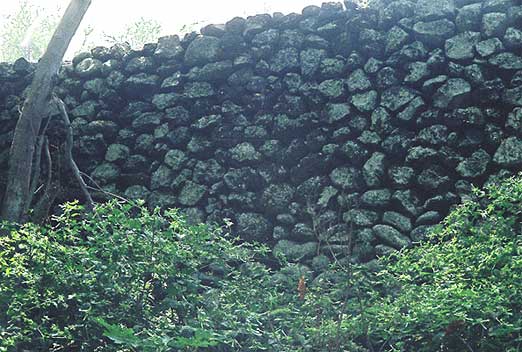
Sixteen foot high north face of Hikiau Heiau
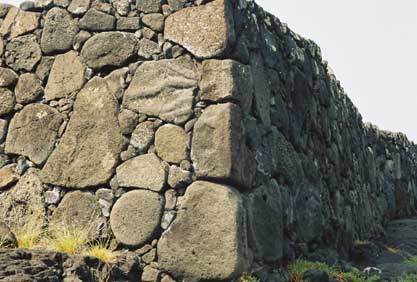
Corner of 'Ale'ale'a Heiau in Pu'uhonua o Honaunau National Historical Park. The larger stones are more than 3 feet across. Excavation revealed seven different stages of construction.
The heiau above, as well as the Great Wall, are both found in Pu'uhonua o Honaunau National Historical Park, sometimes called the City of Refuge. Probably founded ca. 1475 AD, the area was a particularly famous pu'uhonua or place of refuge for kapu breakers or those defeated in war who would normally be put to death at luakini heiau. Honaunau was also the location of a famous sepulcher, or place to house bones of ali'i, the Hale o Keawe, built sometime before 1650. Hale o Keawe at one time housed the bones of at least 23 chiefs, and perhaps those of Captain Cook. It was held in such reverence that when the kapu system was dissolved after the death of Kamehameha I in 1819, when many heiau were destroyed and the sacred images or ki'i pulled down, Hale o Keawe remained untouched. It was standing untouched until 1828, when Queen Ka'ahumanu herself went there, removed the bones, and personally ordered the ki'i destroyed. Artists' sketches of Hale o Keawe made in the early 1820's are the source of the restoration below, particularly of the ki'i.
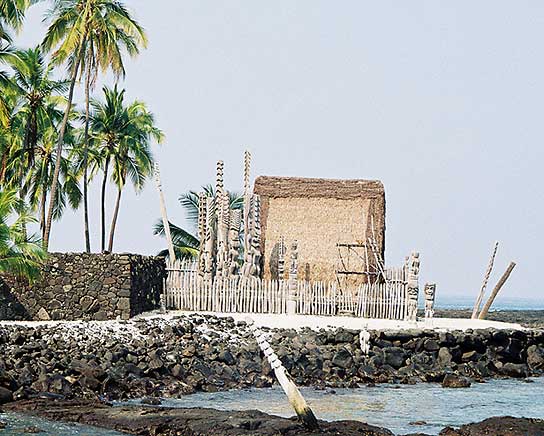
Hale o Keawe today, with Great Wall to the left.
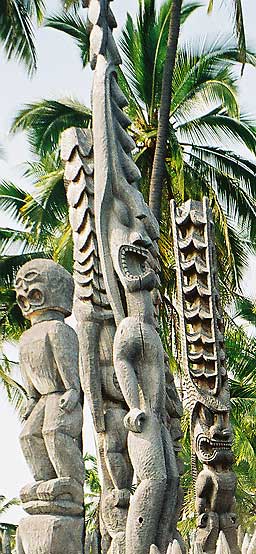
Closer View of some of the ki'i at Hale o Keawe
In the oral tradition of Hawai'i there is evidence of a voyaging period between Hawai'i and what is probably the Society Islands, including Tahiti. Depending upon how many years one allots to a generation, this happened from 1000-1200 AD (30 yr. generation), 1150-1300 (25 yr. generation) or from 1300-1400 (20 yr. generation). The oral traditions of Hawai'i started to be recorded in the 1830's through the rest of the 19th century, long after major change in Hawaiian culture and significant depopulation. As is often the case with oral tradition, accounts of specific events often have more than one version, and are frequently difficult to interpret. This voyaging period is sometimes misrepresented to have brought many immigrants as well as major changes in culture. That is probably not the case. Looking at the oral tradition itself, archaeologist Ross Cordy ( in Exalted Sits the Chief, 2000) notes that over about 150 years of voyaging oral tradition records at most 18 voyages, some one-way, and often involving only one canoe. Eleven of the 18 voyages were undertaken by Hawaiian chiefs, not foreigners.
Pa'ao is the only foreign chief stated to have brought something new, and is credited with bringing new religious ceremonies, new kapu, and a new priestly order involving human sacrifices. He also brought the chief Pili to become a ruler over Kohala, and is credited with building the huge Mo'okini Heiau on 'Upolu Point in Kohala, the center at one time of a vast complex of ali'i residences. (See Lab 4 to read the oral tradition on Pa'ao.)
There is little archaeological evidence of any of this. Cordy demonstrates that there was no abrupt change in heiau styles (the Hawaiians were already building larger heiau than in Tahiti), no evidence of a change in religion or in artifact styles. Archaeologically Hawai'i shows the gradual development that would be typical of a culture changing through time due to the intensification of production and the development of ever-more complex chiefdoms.
Yet almost certainly some contact and voyaging between Hawai'i and Tahiti did occur during this time. In addition to the oral tradition, linguistically there is some evidence of Tahiti contact. And interestingly enough, rat mtDNA would seem to prove contact. The earliest Polynesian settlers brought with them the Pacific rat, Rattus exulans, no doubt as an unintentional stowaway on the canoes. (The Europeans introduced other rat species, but they can not mate with the Pacific rat.) In studies of mtDNA (refer back to unit 1 for discussion of mitochondrial DNA) many modern Pacific rats have mtDNA indicating ancestry to the Pacific rats in the Marquesas; some however have great great great grandmothers that originally came from Tahiti. (Click here to read article on the Pacific rat and what it shows about Polynesian migrations.)
So the voyaging period did occur, and may indeed have contributed something to Hawaiian culture. It probably did not change it in any major way however. Indeed, some archaeologists think that the oral tradition was aided by the ali'i, who use the external "threat" to solidify their power. (In every chiefdom and state, then and now, leaders have used real or imagined external threats to gain power.) According to Cordy, "..the Hawaiian voyaging traditions of the 1200s-1300s are in part local events which have been made into symbolic accounts that document the establishing of some social institutions....and the rise of certain families....[of] hero chiefs..." (Exalted Sits the Chief, p. 179) You are required to read portions of two of the Hawaiian oral traditions for Lab 4.

Mo'okini Heiau today. A massive rectangular enclosure, with walls over 12 feet high and and 9 feet think, Mo'okini was probably constructed in the 1300s AD, and rebuilt by many subsequent rulers. I am standing at one corner of what I think is the most impressive ruin on the islands.
The Northwest Islands: Nihoa and Necker (Mokumanamana)
At some point during the period of expansion into leeward sides of the islands (beginning ca 800 AD), and lasting until shortly after the end of the voyaging period at around 1500, a few hardy pioneers settled on the small northwest island of Nihoa. Archaeologically it appears that Nihoa may once have been home to a permanent population of less than 200 people. Necker Island, or Mokumanamana, some 150 miles to the northwest of Nihoa, may also have held a small permanent population, though it lacks both water and trees. Mokumanamana has long been noted for the numbers of heiau platforms (sometimes called marae from the term used in the Marquesas, because of their density) and for numerous small carved stone figurines. The figurines bear only a slight resemblance to the wooden images found in the main islands. The heads of the figurines bear some resemblance to stone effigy bowls found on Moloka'i, Kaua'i, and the Big Island, though similar stone bowls found on Necker do not have human-like effigies. The main archaeological expedition to the islands was in 1928, (by Kenneth Emory), which recovered most of the stone figurines now in Bishop Museum. A new archaeological expedition (2009), with UH doctoral student Kekuewa Kikiloi, was recently featured in local newspapers. For more on both islands click here for information; for specifics and a brief but interesting video on Kikiloi's work on Mokumanamana, click here. For a more detailed article (discussing both Necker and Nihoa) by archaeologist Koa Kahili, click here. For another short article on both islands, and an excellent picture of one of the figurines, click here.
The actual purpose of the numerous stone platforms and figurines on Necker Island is unknown, though Kahili's and Kikiloi's articles provide some possibilities. In any event, these islands appear not to have been visited after 1500, and there was no record of their occupation or utilization in Hawaiian oral tradition.
Hawai'i at 1500 was well on its way to an intensive agricultural agrarian state, though it possibly did not reach that stage until sometime in the late 1700's. Powerful chiefs on all the main islands competed with each other for both land and power, commanded the labor to intensify food production, and built large religious structures to validate their power. At different times, one chief held sway over an entire island, and there was frequent raids between islands as individual chiefs attempted to increase their power. The population of the islands may have reached its peak by 1600, whether that peak was 250,000 people or as is more likely was closer to one million. The dense population, at least half of whom lived on the Big Island, motivated the chiefs, particularly those on the Big Island, to acquire more land. Besides agricultural land, the fishing areas of Maui, and the fishponds of Moloka'i and O'ahu, must have been particularly desirable. Ke'eku (luakini) Heiau first built around 1480, was rededicated by the Big Island paramount chief Lonoikamakahiki between 1640-1660, with the body of defeated Maui paramount chief Kamalalawalu. The spirits of Kamalalawalu's two grieving dogs are said to continuously guard the site to this day.

Partially restored Ke'eku Heiau in 2008, on the grounds of Outrigger Keauhou Beach Resort, Big Island.

A different sort of heiau: restored Hapaiali'i heiau, where pregnant ali'i gave birth to give their child spiritual power. (Ke'eku Heiau in the background.)
Did Hawai'i develop one or more agrarian states prior to European contact in 1778-1779? Read the next lesson, and the chapter in the text on agrarian states, and decide for yourself. Ultimately there is no magic line that was clearly crossed when a high chiefdom became a state; not in Hawai'i nor anyplace else. Without question Hawai'i was an agrarian state by 1795, when Kamehameha I used guns, huge canoes built with metal adzes, western-style schooners built in his shipyard at Kona, and a very few westerners, to conquer Maui and O'ahu by force. Later, he conquered Kaua'i by diplomacy. In his declining years, Kamehameha I returned from Honolulu to Kona, where he began to focus on the God Lono (agriculture and prosperity) rather than Ku. He built a heiau (Ahu'ena) on the foundations of a much older one on the north shore of Kailua Bay. Restored from an 1816 drawing, Ahu'ena Heiau today is an ironic testament to the lack of prosperity that was to come for Hawaiians. From a population in 1779 of somewhere between 250,000 to more probably close to 1,000,000 people, introduced diseases (review article The Arrow of Disease) and cultural upheaval reduced numbers to a possible 142,000 in the first missionary estimate of 1823; a catastrophic decline regardless of the original numbers. The first formal census of 1832 found 130,300 people, while the 1849 census recorded only 80,600 Hawaiians on all the islands.
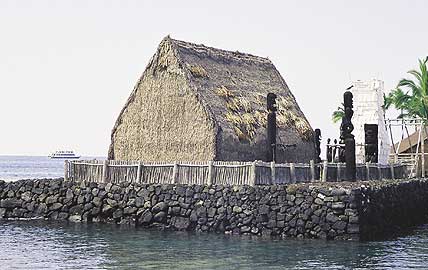
Ahu'ena Heiau, on grounds of King Kamehameha Hotel, Kailua Kona, Hawai'i